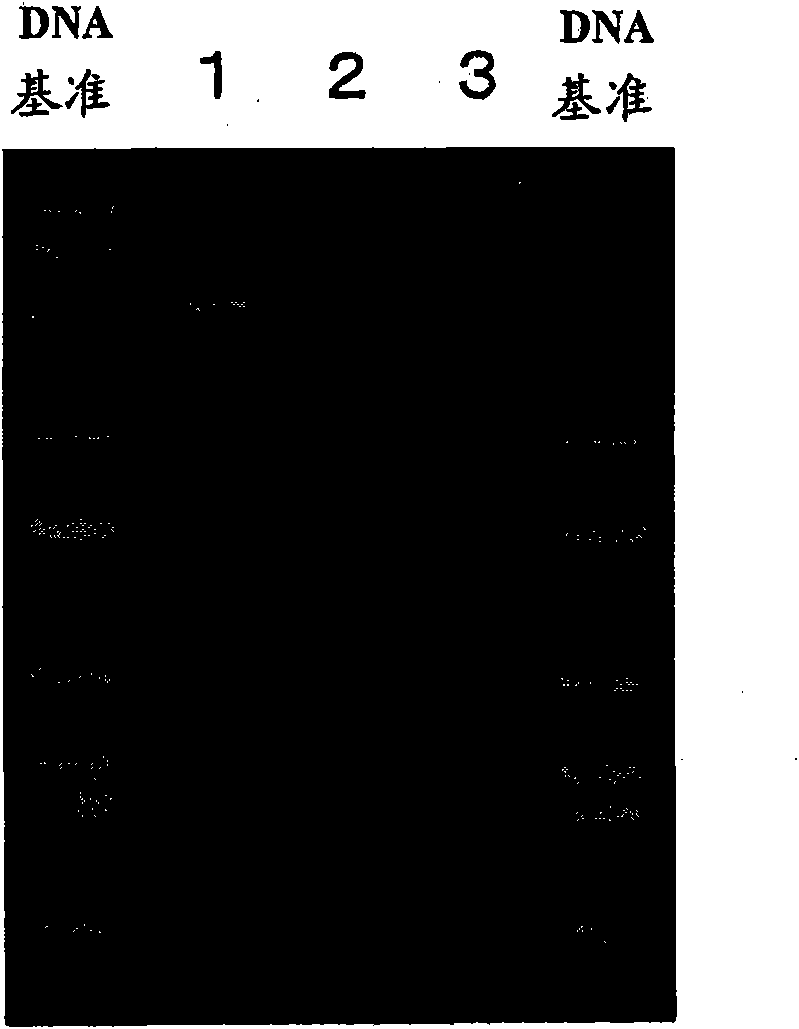Method for maintaining foreign gene in cell stably
A gene and host cell technology, applied in the field of stably maintaining foreign genes, can solve problems such as cell proliferation
- Summary
- Abstract
- Description
- Claims
- Application Information
AI Technical Summary
Problems solved by technology
Method used
Image
Examples
preparation example Construction
[0105] As a procedure for preparing mutant host cells, in addition to the method of systematically deleting or inactivating a gene of interest existing on the host chromosome, it is also possible to give random gene deletion or inactivation mutations, followed by appropriate methods. A method for gene analysis or protein productivity evaluation.
[0106] To delete or inactivate a gene of interest, for example, homologous recombination can be used. That is, the DNA fragment containing a part of the target gene is cloned into an appropriate plasmid vector, the resulting circular recombinant plasmid or the DNA fragment on the linear chain is integrated into the host cell, and the parent is truncated by homologous recombination of a part of the target gene The target gene on the microbial genome is inactivated. Alternatively, a method such as PCR is used to construct a target gene introduced with an inactivating mutation caused by base substitution or base insertion, or a linear ...
Embodiment 1
[0136] [Example 1] Introducing a dye with tryptophanyl tRNA synthetase gene into a Bacillus subtilis strain in vitro gene
[0137] The extrachromosomal gene carrying the tryptophanyl tRNA synthetase gene, plasmid pDATS14, was constructed as follows. First, PCR amplification was performed using primers A and B using a general-purpose Bacillus subtilis-Escherichia coli shuttle plasmid, pHY300PLK (manufactured by Yakult Co., Ltd.), as a template. Restriction enzyme wxya After digestion, a circular plasmid is formed by ligating the two ends. This plasmid was used to transform Escherichia coli HB101 strain. A plasmid was prepared from the transformant and designated as pDA2. On the other hand, using the chromosome of Bacillus subtilis ISW1214 strain as a template, primers C and D were used to obtain a DNA fragment containing tryptophanyl tRNA synthetase gene and its adjacent region. restriction enzyme wxya The DNA fragment was digested and pre-treated with restriction en...
Embodiment 2
[0138] [Example 2] Used to destroy the tryptophanyl tRNA synthetase gene on the chromosome of Bacillus subtilis strain Construction of DNA Fragments
[0139] Using the chromosome of Bacillus subtilis ISW1214 strain as a template, using primers E and F, a DNA fragment of about 2.5 kb containing tryptophanyl tRNA synthetase gene and its adjacent regions was obtained. restriction enzyme EcoRI and SalI Digestion. post and pre pass EcoRI and SalI The digested universal plasmid pUC18 was ligated to obtain plasmid pTSAF. On the other hand, using the universal plasmid pC194 as a template and using primers G and H, a DNA fragment of about 1.6 kb containing the chloramphenicol resistance gene and its adjacent regions from Staphylococcus was obtained. Using pTSAF as a template, PCR reaction was carried out using primers I and J to obtain DNA fragments. The DNA fragment and a DNA fragment of about 1.6 kb containing the chloramphenicol resistance gene and its adjacent region ...
PUM
 Login to View More
Login to View More Abstract
Description
Claims
Application Information
 Login to View More
Login to View More - R&D
- Intellectual Property
- Life Sciences
- Materials
- Tech Scout
- Unparalleled Data Quality
- Higher Quality Content
- 60% Fewer Hallucinations
Browse by: Latest US Patents, China's latest patents, Technical Efficacy Thesaurus, Application Domain, Technology Topic, Popular Technical Reports.
© 2025 PatSnap. All rights reserved.Legal|Privacy policy|Modern Slavery Act Transparency Statement|Sitemap|About US| Contact US: help@patsnap.com

